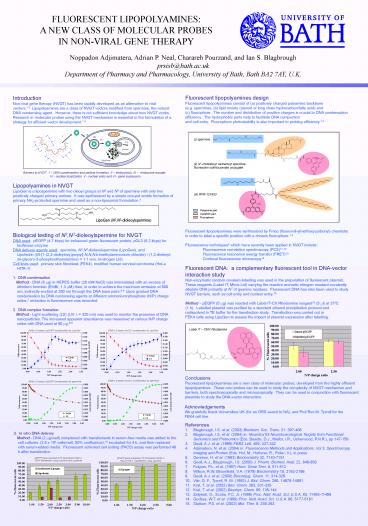FLUORESCENT LIPOPOLYAMINES: - PowerPoint PPT Presentation
1 / 1
Title:
FLUORESCENT LIPOPOLYAMINES:
Description:
Non-viral gene therapy (NVGT) has been rapidly developed as an alternative to ... (e.g. spermine), (b) lipid moiety (steroid or long chain hydrocarbon/fatty acid) and ... – PowerPoint PPT presentation
Number of Views:37
Avg rating:3.0/5.0
Title: FLUORESCENT LIPOPOLYAMINES:
1
FLUORESCENT LIPOPOLYAMINES A NEW CLASS OF
MOLECULAR PROBES IN NON-VIRAL GENE THERAPY
Noppadon Adjimatera, Adrian P. Neal, Charareh
Pourzand, and Ian S. Blagbrough
prsisb_at_bath.ac.uk Department of Pharmacy and
Pharmacology, University of Bath, Bath BA2 7AY,
U.K.
Fluorescent lipopolyamines design Fluorescent
lipopolyamines consist of (a) positively charged
polyamine backbone (e.g. spermine), (b) lipid
moiety (steroid or long chain hydrocarbon/fatty
acid) and (c) fluorophore. The number and
distribution of positive charges is crucial to
DNA condensation efficiency. The hydrophobic
parts help to facilitate DNA compaction and cell
entry. Fluorophore photostability is also
important to probing efficiency.1,4
IntroductionNon-viral gene therapy (NVGT) has
been rapidly developed as an alternative to viral
vectors.1-3 Lipopolyamines are a class of NVGT
vectors modified from spermine, the natural DNA
condensing agent. However, there is not
sufficient knowledge about how NVGT works.
Research in molecular probes using the NVGT
mechanism is essential in the formulation of a
strategy for efficient vector development.1,4
II
I
III
(i) spermine
IV
V
VI
NPC
Nucleus
Cytoplasm
(ii) N1-cholesteryl carbamoyl spermine-fluorescei
n isothiocyanate conjugate
Cell membrane
Barriers to NVGT I DNA condensation and
particle formation, II endocytosis, III
endosome escape,
IV - nuclear localization, V - nuclear entry and
VI - gene expression
Lipopolyamines in NVGT LipoGen is a lipospermine
with two oleoyl groups at N2 and N3 of spermine
with only two positively charged primary amines.
It was synthesized by a simple one-pot amide
formation of primary NH2-protected spermine and
used as a non-liposomal formulation.4
(iii) RPR-121653
Polyamine part
Lipophilic part
Fluorophore
Fluorescent lipopolyamines were synthesized by
Fmoc (fluoren-9-ylmethoxycarbonyl) chemistry in
order to label a specific position with a chosen
fluorophore.1,4 Fluorescence techniques4 which
have recently been applied in NVGT include
Fluorescence correlation spectroscopy
(FCS)11-12 Fluorescence resonance energy
transfer (FRET)13 Confocal fluorescence
microscopy14
- Biological testing of N2,N3-dioleoylspermine for
NVGT - DNA used pEGFP (4.7 kbps) for enhanced green
fluorescent protein, pGL3 (5.2 kbps) for
luciferase enzyme - DNA delivery agents used spermine,
N2,N3-dioleoylspermine (LipoGen), and Lipofectin
((N-1-(2,3-dioleyloxy)propyl-N,N,N-trimethylammo
nium chloride) / (1,2-dioleoyl-sn-glycero-3-phosph
oethanolamine) 11 w/w, Invitrogen Ltd) - Cell lines used primary skin fibroblast (FEK4),
modified human cervical carcinoma (HeLa HtTA-1) - 1. DNA condensation
- Method - DNA (6 mg) in HEPES buffer (20 mM
NaCl) was intercalated with an excess of ethidium
bromide (EthBr, 1.3 mM) then, in order to achieve
the maximum emission at 600 nm, indirectly
excited at 260 nm through the DNA base pairs.5-6
Upon gradual DNA condensation by DNA condensing
agents at different ammonium/phosphate (N/P)
charge ratios,7 reduction in fluorescence was
recorded. - 2. DNA complex formation
- Method - Light scattering (LS) (UV l 320 nm)
was used to monitor the presence of DNA
nanoparticles. The increased apparent absorbance
was measured at various N/P charge ratios with
DNA used at 60 mg.8-9
Fluorescent DNA a complementary fluorescent
tool in DNA-vector interaction study
Non-enzymatic random covalent-labelling was used
in the preparation of fluorescent plasmid. These
reagents (Label IT, Mirus Ltd) carrying the
reactive aromatic nitrogen mustard covalently
alkylate DNA primarily at N7 of guanine residues.
Fluorescent DNA has also been used to study NVGT
barriers, such as cell entry and nuclear entry.15
Method pEGFP (5 mg) was reacted with Label
IT-CX Rhodamine reagent15 (5 ml) at 37oC(1 h).
Labelled plasmid was purified by a standard
ethanol precipitation protocol and redissolved
in TE buffer for the transfection study.
Transfection was carried out in FEK4 cells using
LipoGen to assess the impact of plasmid
expression after labelling.
Label IT CMX Rhodamine
Conclusions Fluorescent lipopolyamines are a
new class of molecular probes, developed from the
highly efficient lipopolyamines. These new
probes can be used to study the complexity of
NVGT mechanism and barriers, both
spectroscopically and microscopically. They can
be used in conjunction with fluorescent plasmids
to study the DNA-vector interaction.
Acknowledgements We gratefully thank Universities
UK (for an ORS award to NA), and Prof Rex M.
Tyrrell for the FEK4 cell line.
- References
- Blagbrough, I.S. et al. (2003) Biochem. Soc.
Trans. 31 397-406 - Blagbrough, I.S. et al. (2004) in Neurotox03
Neurotoxicological Targets from Functional
Genomics and Proteomics (Eds. Beadle, D.J.,
Mellor, I.R., Usherwood, P.N.R.), pp 147-159 - Geall, A.J. et al. (1999) FEBS Lett. 459, 337-342
- Adjimatera, N. et al. (2004) in Fluorescence
Methods and Applications, Vol 3, Spectroscopy,
Imaging and Probes (Eds. Hof, M., Hutterer, R.,
Fidler, V.), in press - Gershon, H. et al. (1993) Biochemistry 32,
7143-7151 - Geall, A.J., Blagbrough, I.S. (2000) J. Pharm.
Biomed. Anal. 22, 849-859 - Felgner, P.L. et al. (1997) Hum. Gene Ther. 8,
511-512 - Wilson, R.W, Bloomfield, V.A. (1979) Biochemistry
18, 2192-2196 - Geall, A.J. et al. (2000) Bioconjug. Chem. 11,
314-326 - Vile, G. F., Tyrrell, R. M. (1993) J. Biol. Chem.
268, 14678-14681 - Kral, T. et al. (2002) Biol. Chem. 383, 331-335
- Kral, T. et al. (2002) Biophys. Chem. 95, 135-144
- Zelphati, O., Szoka, F.C. Jr. (1996) Proc. Natl.
Acad. Sci. U.S.A. 93, 11493-11498 - Godbey, W.T. et al. (1999) Proc. Natl. Acad. Sci.
U.S.A. 96, 5177-5181 - Slattum, P.S. et al. (2003) Mol. Ther. 8, 255-263
3. In vitro DNA delivery Method - DNA (2
mg/well) complexed with transfectants in
serum-free media was added to the cell cultures
(2.5 x 104 cells/well, 50 confluence),10
incubated for 4 h, and then replaced with
serum-added media. Fluorescent activated cell
sorting (FACS) assay was performed 48 h after
transfection.
pEGFP gene expression ( fluorescent cells) in
FEK4 transfection using LipoGen and Lipofectin
pEGFP gene expression ( fluorescent cells) in
HeLa HtTA-1 transfection using LipoGen

